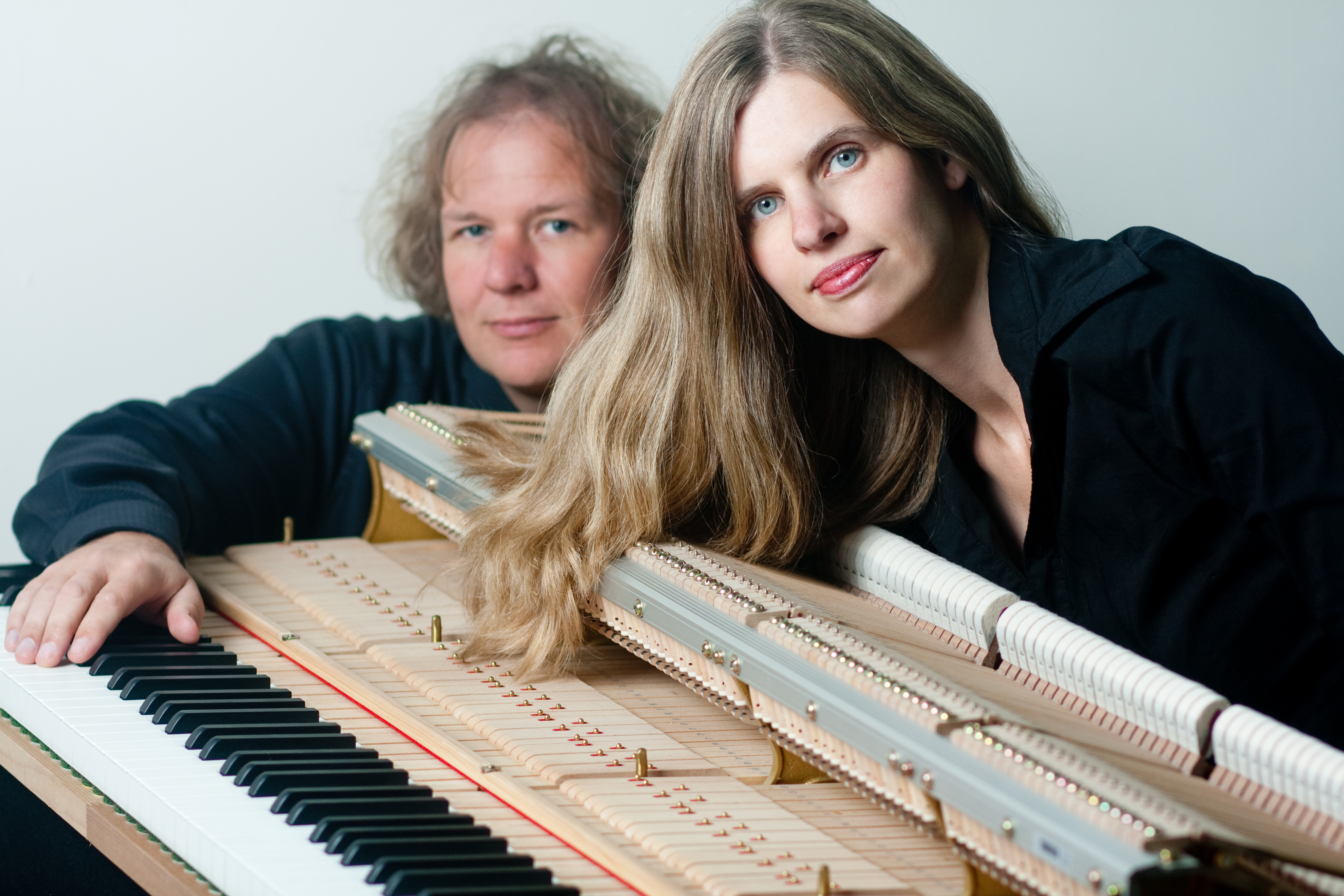Complete Simeon ten Holt Multiple pianos
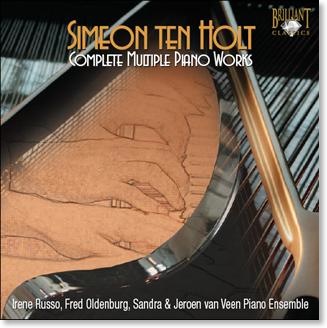
Composer: Simeon ten Holt
All on four Grand Pianos!
Canto Ostinato
Lemniscaat
Horizon
Incantatie IV
Meandres
Schadow nor Prey
11 Cd box.
Delivery in The Netherlands often within 48 hours!
Item: BC7795
Irene Russo, Fred Oldenburg, Sandra & Jeroen van Veen
Piano Ensemble
|
|
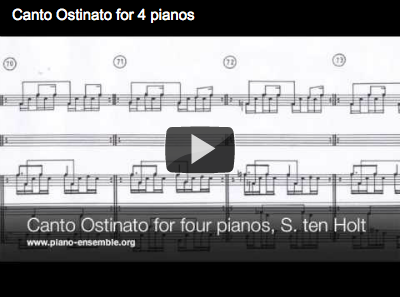
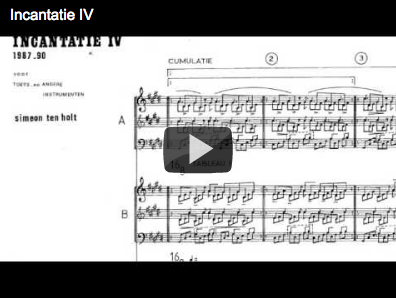
|
|
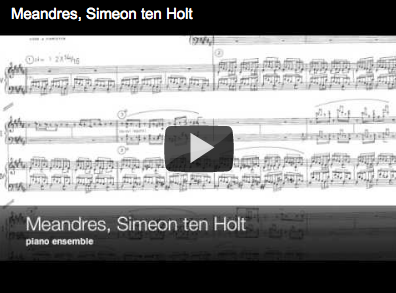
|
|
|
|
Tracklist:
CD I: Canto Ostinato CD I
(1976-1979
01 Section 1 03:54
02 Section 5 04:14
03 Section 10 05:20
04 Section 14 08:42
05 Section 20 08:10
06 Section 25 07:01
07 Section 35 05:19
08 Section 41 07:47
09 Section 56 03:59
10 Section 60 01:10
11 Section 69 04:10
12 Theme I, Section 74 05:11
13 Section 78 03:22
14 Section 83 06:31
Total playing time: 75:00
CD II: Canto Ostinato CD II
01 Section 88 A 07:32
02 Section 88 B 08:43
03 Section 88 E 05:47
04 Section 88 F 08:44
05 Section 88 C 06:26
06 Section 89 02:38
07 Section 91 A 02:42
08 Section 91 C 04:17
09 Section 91 E 08:00
10 Section 92 01:31
11 Theme II, Section 95 04:58
12 Section 97 03:50
13 Section 105 01:43
14 Section 106 03:07
Total playing time: 70:06
CD III: Lemniscaat CD I
(1982-1983)
01 Refrain 01:45
02 Episode I 08:12
03 Episode II 12:26
04 Episode III 09:33
05 Episode IVa 01:46
06 Episode VIb 09:49
07 Episode V 05:58
08 Episode VIa 08:29
09 Episode VIb 03:19
10 Episode VIc 02:45
11 Episode VIIa 01:40
12 Episode VIIb 05:08
13 Episode VIII 07:17
Total playing time: 78:13
CD IV: Lemniscaat CD II
01 Refrain 01:44
02 Introduction Episode IX 03:31
03 Episode IX 10:59
04 Episode X 02:01
05 Episode XI 04:41
06 Episode XII 04:11
07 Episode XIII 06:16
08 Episode XIVa 03:20
09 Episode XIVc 02:58
10 Episode XV 04:52
11 Episode XVIa 02:04
12 Episode XVIb 01:47
13 Episode XVIc 02:58
14 Refrain 01:51
Total playing time: 53:22
CD V: Horizon CD I
(1983-1985)
01 Section 1 06:08
02 Section 11 06:13
03 Section 19 08:20
04 Section 26 07:25
05 Section 38 10:05
06 Section 51 07:53
07 Section 71, Cumulation 08:19
08 Section 78, Cumulation 06:27
09 Section 85, Cumulation 08:44
10 Section 91 09:32
Total playing time: 79:12
CD VI: Horizon CD II
01 Section 98 05:42
02 Section 106 05:45
03 Section 111 07:06
04 Section 121 12:09
05 Section 137 07:41
06 Section 146 03:45
07 Section 151 03:11
08 Section 155 04:45
09 Section 162 07:43
Total playing time: 57:52
CD VII: Incantatie IV CD I
(1987-1990)
01 Tableau I, Section 1 11:44
02 Section 20 01:19
03 Section 22 04:07
04 Da Capo 09:12
05 Tableau II, Section 27 06:13
06 Section 35b 07:59
07 Tableau III, Section 45 06:34
08 Section 54 03:00
09 Section 60 03:22
10 Tableau IV, Section 69 04:18
11 Section 76a 02:31
Total playing time: 60:27
CD VIII: Incantatie IV CD II
01 Section 78 10:39
02 Cumulation I, Section 121 05:28
03 Cumulation II, Section 140 04:03
04 Tableau V, Section 148 05:55
05 Cumulation III, Section 154 07:00
06 Section 165 10:54
07 Tableau VI, Section 197 05:03
08 Tableau VII, Section 204 03:59
09 Section 210 03:27
Total playing time: 56:35
CD IX: Meandres CD I
(1997)
01 Introduction 01:05
02 Section 1 19:00
03 Section 16 05:05
04 Section 20 11:05
05 Section 42 01:42
06 Section 45 06:26
07 Section 53 12:03
08 Section 74 07:08
Total playing time: 63:38
CD X: Meandres CD II
01 Section 87 06:43
02 Section 101 09:08
03 Section 125 03:15
04 Section 130 02:59
05 Section 135 04:51
06 Section 145 02:46
07 Section 149 09:28
08 Section 167 03:05
Total playing time: 42:20
CD XI: Shadow nor Prey
(1993-1995)
01 Section 1 08:00
02 Section 14a 00:54
03 Da Capo 11:10
04 Section 16a 03:39
05 Section 19a 05:29
06 Section 21a 04:52
07 Section 25a 05:12
08 Canzona 28a 03:51
09 Section 29 03:41
10 Section 36 08:28
11 Section 52a 00:45
12 Section 53 08:02
Total playing time: 64:09
* live recording
|
|
Simeon ten Holt
|
Simeon ten Holt was born in Bergen (N.H.) in the Netherlands in 1923. From 1935 he studied piano and theory with Jacob van Domselaer (1890-1960) - the musical representative of the movement 'De Stijl". He continued his studies in Paris at the Ecole Normale with Honegger and Milhaud. During the sixties Ten Holt immersed himself in serialism. He tried to grasp what he called 'the semantics of musical language' and looked for ways in which he could expand the possibilities of his musical expression. During the seventies, Ten Holt concentrated on tone and timbre and on sonology. His masterwork Canto Ostinato, in which he returned to a more conventional style of composing, was premiered in 1979 in the 'Ruine Kerk' in Bergen (province of Noord-Holland). The work was performed on three pianos and electronic organ. Later on Ten Holt felt that the best performance option would be four equal-sized grand pianos; however, the score still bears the subtitle: for keyboards.
"'There's Simeon ten Holt and then there's all the rest,' the composer of works such as Canto Ostinato, Horizon and Lemniscaat once said jokingly of his own position in Dutch musical life'. Even today, one could say that, in a sense, this is still true. Anyone challenging a select group of contemporary music lovers to a fiery debate need only mention a single composer's name: that of Simeon ten Holt (b. 1923). In the late 1970s, Ten Holt provoked the wrath of countless musical know-alls by returning to sounds that every ear could understand. He had the courage to abandon the complex, twelve-tone scores of the post-war era, which he traded in for simple triads, shifting rhythmic patterns and repeat signs. Completely independent of American composers like Steve Reich and Philip Glass, Ten Holt created a Dutch version of minimal music". (Paul Janssen)
Now what is so typical to Simeon ten Holts music? In what does his musical process differ so much from that of other contemporary composers? In Ten Holts music the score is complex, in that it contains a lot of different layers, like a multi-track composition. In classical music the final decisions about what and how to play are typically made by the composer; here instead, the performers are the decision-makers and are therefore part of the recreation of the composition. During rehearsals for instance, the ensemble may decide to skip certain decisions or write/compose a way to go through the music. In doing so, all performers within the ensemble have an equal input as well as equal influence on the decisions. In other words, there is no leading 'first piano'.
All compositions in this box were written down in large books. Each composition contains approximately a hundred to two hundred sections. Ninety-five percent of all sections may be repeated, the other five percent are so called 'bridges' and only appear once. Repetition in this case serves to create a situation in which the musical object affirms its independence and can search the most favorable position with respect to the light thrown on it, becoming transparent. Time becomes the space in which the musical object floats. The musicians navigate through these sections by giving each other visual signs and may even go backwards instead of forward. There is no fixed duration for a piece, but a performance may easily last a couple of hours. The first performance of Lemniscaat, for instance, lasted for thirty hours! This extreme flexibility was completely new to modern music, especially since Ten Holt's music is based on the natural laws of harmony: tension and relaxation. The music has been constructed within the principle of tonality, but since the duration is more or less stretched, it brings a new perspective to the musical experience. All of this in combination with the democratic process of creation has been a major influence on contemporary music.
Simeon ten Holt about his music
- My compositions take shape without any predetermined plan and are, as it were, the reflection of a quest for an unknown goal. A great deal of time, patience and discipline are the prerequisites for making a (genetic) code productive, that eventually determines form, structure, length, instrumentation etc. Such a process is laborious, as the perception of this generating code is constantly being troubled by human shortcomings and one's own will, and it is dependent on moments of clarity and vitality. And then, the sea washes and polishes, time crystallizes.
- The only advantage of ageing may be that a development can be viewed in retrospect. And that, in spite of the zigzag movements and the apparently opposing directions, one is able to discern logic in this development that hitherto had a function that was hidden and blocked from view. A road then seems to appear, which is oriented towards a goal shrouded in mystery, momentarily hardly gains in height and only advances in the curves. In this image the curves refer to so many turning points, not only as changes in the perception of the landscape, but mainly as changes with regards to the attitude to life and a revision of the conditions to pursue the road any further. The curves are like the articulation in a pattern of movement, end and beginning from one phase to another, and appear to coincide with biological periodicity, with intervals from seven to ten years. As far as I can see, my relationship, both metaphorically and practically, to the tonal centre and the problem of tonality, has been a determining factor in the development of the achievements in my creative career. This relation gradually shifted from an initial intuitive understanding to a more conscious issue later on. The role of the tonal centre, first as an undisputed factor, starts to move, loses its authority, submerges into chromaticism and the equality of all tones, and finally emerges in a shape that is chastened by death and katharsis. A large-scale history reproduces itself on a small scale.
- I was very surprised to find myself in a steppe-like landscape one day, which was characterized by an immense horizon, by vastness, space and time, and, last but not least: by tonal centres and tonality (Canto Ostinato). In spite of various speculations I have not been able to find an adequate explanation for this development yet and, just like before, I have no idea of the next port to which my compass is set.
Simeon ten Holt
Bergen, June 1995
www.simeontenholt.com|
|
|
Simeon ten Holt in my life
|
In my childhood I listened to the radio every night. One night I heard a piece which was so beautiful; I heard more than one piano, it was in a tonal repetitive style but definitely not boring. The colouring from the melting piano sounds was impressive to me all the time. I loved the process very much. But since it was the premiere of Horizon (as I found out years later) which went on until midnight, I fell asleep and left me with the question who wrote this wonderful music I never heard before in my life. It was in 1993 after having graduated from the Conservatory that I found time to investigate the authorship. At that time I was playing a lot of contemporary music and now my hands were attracted to the keys, a natural 'hunger' to play this tonal music.
Then I found the composer I was looking for: Simeon ten Holt. I ordered the scores from Donemus (the Dutch music publisher) and sat down at the piano. My hands were pulled to the keys and found a mixture of Bach and Chopin-like piano technique. The result of playing these repeated sections was that for the first time in my life I experienced a rich and colourful pallet of possibilities in piano sound. The harmonics are so rich, due to the repeated sections. When I played the music on two pianos with my wife Sandra, it was even more intense! What is more beautiful than one piano: two pianos!
But after playing Canto Ostinato on four pianos I really had to change my opinion. The ultimate sound could be achieved by playing on four grand pianos, since it gave the possibilities to play almost without pedal, and keep a very clear sound, so that one is able to play as many minimal variations as possible. The millions of variations that become possible with four people on four instruments, propose a challenge. Still, each concert is different in sound and shape. The communication among the musicians on stage is very important; besides, it is interesting for the audience to watch.
After we had made our first CD, featuring Canto Ostinato, in 1996, we were invited to Simeon's place in Bergen. We talked a lot and the foundation of a long friendship was laid. In 2001 we founded the Simeon Ten Holt Foundation, with board members Sandra van Veen, secretary, Ton van Asseldonk, treasurer and myself as chairman. We hope to promote Simeons music all over the world and bring it to many music lovers!
Jeroen van Veen
Simeon ten Holt Foundation
Piano Ensemble
The Piano Ensemble was founded in 2000 by Fred Oldenburg and Jeroen van Veen, in order to present the piano music they play in various international ensembles. Multiple piano playing is one of their missions; from one up to 6 pianos. Premieres were given in Canada, the United States, Russia and the Netherlands, of works by Dutch composers like Simeon ten Holt and Chiel Meijering and of British composers like Gabriel Jackson and Tim Seddon. Current members of the Piano Ensemble are: Elizabeth & Marcel Bergmann (Canada), Irene Russo, (Italy) Fred Oldenburg (The Netherlands) and Sandra & Jeroen van Veen (The Netherlands). Most of the premieres took place in Culemborg, where the Lek Art Foundation organizes a concert and an Art Festival every year. The line-up on these CDs is that of Irene Russo, Fred Oldenburg and Sandra & Jeroen van Veen, all playing on Fazioli grand pianos.
www.piano-ensemble.org
|
|
Irene Russo
|
Praised by the legendary Martha Argerich as "one of the best young musicians I ever heard in my life", the Italian pianist Irene Russo (1974) appeared on the big international stages as one of the most interesting talents of her generation.
Her international career started in 1993 in Sydney. Since then Ms. Russo has played extensively through all of Europe, the United States, Latin America, Canada and Israel: she has performed in many important concert venues, including: Bruxelles' Palais des Beaux-Arts, Bologna's Teatro Comunale, New York's Steinway Hall, Naples' Teatro San Carlo, Buenos Aires' Teatro Colon, Milan's Auditorium Verdi, in Houston, Amsterdam, Calgary, Berlin, Lisbon, Cleveland, Zurich, Tel Aviv, Freiburg, Antwerp, etc. Recently Ms. Russo has been invited to play at the Schloss-Elmau Festival, Robert Schumann Festival and Beethoven Klavier Festival.
Ms. Russo's most recent engagements included highly acclaimed debuts at La Roque d'Anthéron International Piano Festival and Munich's deGasteig.
In recent seasons, Irene Russo has appeared as guest soloist with leading orchestras, among which: Düsseldorfer Symphoniker, Orchestra Sinfonica del Teatro San Carlo, deFilharmonie van Vlaanderen, Münchener Kammerorchester, Craiova Symphony Orchestra, Brandenburgisches Staatsorchester Frankfurt, Orchestra da Camera di Mantova, Houston OrchestraX, Klassische Philharmonie. She has collaborated with leading conductors including: Umberto Benedetti Michelangeli, David Stern, Alexander Liebreich, Marc Andreae, Misha Damev, Heribert Beissel, John Axelrod, Susanna Mälkki, Ovidiu Balan, Michel Tilkin.
In 2000, Ms. Russo impressed a very prestigious Jury, from Joachim Kaiser ("Irene Russo reminds me of the young Kempff") to some of the most famous pianists in the world such as Nelson Freire, Maria Tipo and Martha Argerich: she became the winner of the Clara Schumann International Piano Competition in Düsseldorf. Since then Ms. Russo has been invited to play in the most important concert halls in Germany, including Bonn's Beethovenhalle, Bremen's dieGlocke, Nürnberg's Meistersingerhalle, Düsseldorf's Tonhalle, Hannover's Theater am Aegi, Hamburg's Musikhalle, Munich's Herkulessaal and Prinzregententheater, both as soloist and with orchestra.
A Prize Winner of the 2002 ARD International Piano Competition in Munich, where she received the Special Prize for the Best Interpretation of the Contemporary Music, and First Prize Winner at the 1999 Emmanuel Durlet International Piano Competition in Antwerp, Irene Russo was also awarded the Special Mention of Honour at the 2003 Martha Argerich International Piano Competition in Buenos Aires.
She has recorded live on Italian Television RAI, Belgian Radio Klara, CBC Canada, Radio Vaticana, Bayerische Rundfunk, ARD, NDR, SWR, Radio-4 Holland; she also appeared in a music documentary on ZDF.
In 2002 she was appointed professor at the "Umberto Giordano" National Music Conservatory in Italy; Ms. Russo is regularly invited to take part in the jury of international piano competitions and gives master classes throughout Europe.
She has recorded for Oehms Classics and BOA Video.
Among her teachers: Lazar Berman ("Irene Russo is one of the best students I've ever had") at the International Piano Academy "Incontri col Maestro" in Imola, and Alicia de Larrocha ("She is absolutely fabulous!") in Barcelona.|
|
|
Jeroen Van Veen
|
Jeroen Van Veen (1969) started playing the piano at the age of 7. He studied at the Utrecht Conservatory with Alwin Bär and Håkon Austbö. In 1993 he passed the Performing Artists' Exam. Van Veen played with orchestras conducted by Howard Williams (Adams), Peter Eötvös (Zimmermann) in Amsterdam, Utrecht, Vienna and Budapest and in the United States with Neal Stuulberg (Mozart & Bartok) and Robert Craft (Stravinsky) He played recitals in Austria, Belgium, Canada, England, France, Germany, Hungary, Italy, Russia & the USA.
Van Veen followed masterclasses with Claude Helffer, Hans-Peter & Volker Stenzl and Roberto Szidon. He was invited at several festivals; Reder Piano Festival (1988), Festival der Kunsten in Bad Gleichenberg (1992), Wien Modern (1993), Holland Dance Festival (1998) Lek Art Festival (1996-2005). Van Veen recorded for major Dutch Radio- and Television companies like AVRO, NOS, IKON, NCRV, TROS/Internet and for WTBC-TV & Radio (Florida, U.S.A.).
In 1992, Van Veen recorded his first CD with his brother Maarten as the internationally recognized Pianoduo Van Veen. In 1995 Pianoduo Van Veen made their debut in the United States. They were prize winner in the prestigious 4th International Murray Dranoff Two Piano Competition in Miami, Florida. After this achievement they toured the United States for several times. The documentary "Two Pianos One Passion" (nominated with an Emmy Award 1996) follows them as a duo.
Besides performing, Jeroen teaches at the University of Utrecht, and is co-founder, member of the jury and artistic director of the International Student Piano Competition which is held in Utrecht every two years.
In 1995 Jeroen Van Veen founded Van Veen & Van Veen (Van Veen & Co.), which is a pianoduo with his wife Sandra. As such, they mainly perform music for multiple pianos by the Dutch composer Simeon ten Holt.
Furthermore, in 1999 Van Veen started a concert series 'Pianova' in the Concertgebouw, Amsterdam.
Beside his career as a solo pianist Van Veen also partakes in the following ensembles: 'Kunstgroep vier man op de stoep', 'Piano Ensemble', 'The International Piano Quartet', 'The Simeon Quartet' 'Piano Mania', 'DJ Piano' and 'Jeroen van Veen & Friends'.
The various compositions by Van Veen may be described as 'Minimal Music' with different faces, Crossovers to Jazz, Blues, Soundscape, AvantGarde, Techno, Trance and Pop Music.
Currently Mr Van Veen is director of Van Veen Productions, Chairman of the Simeon ten Holt Foundation, Artistic director of several music festivals in Culemborg, Utrecht, Veldhoven and Alkmaar. Over the last 15 years Van Veen recorded more than 25 CDs for several labels (Mirasound, Koch, Naxos, Brilliant Classics) and his own label PIANO.
Since 2005 he is Director of Artistic Development Overseas at the International Murray Dranoff Two Piano Competition based in Miami, United States.
|
|
|
Sandra van Veen
Sandra van Veen studied with the Norwegian pianist Håkon Austbö at the Conservatory in Utrecht where she graduated in 1992. She made her debut with her husband Jeroen in a performance of Canto Ostinato during Lek Art (Culemborg). The concert was live recorded and the CD has sold in more than 40 countries worldwide. After this, many concerts and Cds followed. Sandra is very dedicated to the music of Ten Holt, but nowadays she also plays other kinds of music, ranging from the Carmina Burana, The Planets, Rhapsody in Blue, to Tangos and Tubular Bells for four pianos. She did the premiere of several pieces written by Dutch composers like J. Andriessen (in Russia) and Ten Holt (in Canada). Furthermore, she forms an Art group with two friends, with whom she makes theatre concerts based on different themes, for example a "Composers Life" or the "History Of The Piano".
Concerts and recitals brought Sandra from Miami to Russian Novosibirsk. She takes part in many projects in Holland as well as abroad. She recorded 13 CDs on various labels. Several concerts and projects have been broadcasted on radio, television and the Internet. Finally, Sandra is a well known, passionated piano teacher as well.
Sandra van Veen is a co-founder of the Lek Art Foundation and the Simeon ten Holt Foundation, and is active as a secretary for the last one.
|
|
Fred Oldenburg
Fred Oldenburg (1955) started playing the piano at the age of 5. He studied at the Royal Conservatory at The Hague with Theo Bruins. He continued his studies at the Juilliard School of Music in New York with Beveridge Webster and in Brussels with Eduardo del Pueyo. In 1980 he received the 'Prix d'Excellence'. Mr. Oldenburg performs as a soloist, chamber musician and as an accompanist. He gave concerts and made Radio- and TV- broadcastings in different countries over the world. Fred Oldenburg made many CD recordings, among them 12 Etudes d'Exécution Transcendante by Franz Liszt. Mr Oldenburg was involved in performing the Ten Holt pieces since their premieres.
|
|
Fazioli Grand Pianos, 2 x 2.78m. and 2 x 2.28m.
Pianos supplied by Evert Snel, Werkhoven
Piano technician: Frank van Ham.
Produced by: Van Veen Productions for Brilliant Classics
Executive Producer: Jeroen Van Veen
Engineered by: Fred Oldenburg, Sabine Oldenburg and Jeroen van Veen
Mastering: Piano Mania
Recorded on ADAT, 8 tracks on 24 bit, 48 KHz.
Scores: Donemus, Amsterdam
Software: Pro Tools & Samplitude
Recording location: Barbara Church, Culemborg
Recording dates: May 23rd - 27th (2005), CD 11, September 20th (2003) (live registration during Lek Art Concert 2003)
Thanks to Clavis, Sem van Gelder, Hervormde Gemeente Culemborg, Kunstenaarscentrum Bergen, Bram van Schaik, Simeon ten Holt Foundation, Evert Snel, Stichting Lek Art, Thuiskopiefonds,
Photos: William Hoogteyling
|

